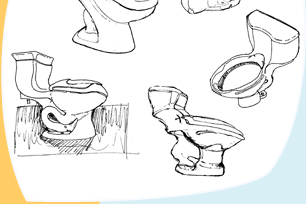 |
From
a manufacturing point of view, making a vastly different toilet is a considerable
challenge. Most existing characteristics have real purposes. For example,
the pedestal section under the bowl has to be a certain size and shape in
order to support the soft clay bowl when it is fired in a kiln. We studied
forms that were compatible with the manufacturing process—the traditional
form of the toilet, in large part, is the result of how it is made. We visited
earthenware factories and studied the hand-made qualities of the process.
American Standard encouraged us to explore outside of existing manufacturing
constraints. Surprisingly, the century-old process was making a sanitary,
inexpensive product like clay pots! Psychological factors also supported
little change, because change gets noticed. We looked at various designs
which expressed "toiletness" and considered retro notions filled
with architectural elements that would fit well in bathroom environments.
|
 |
 |
|













